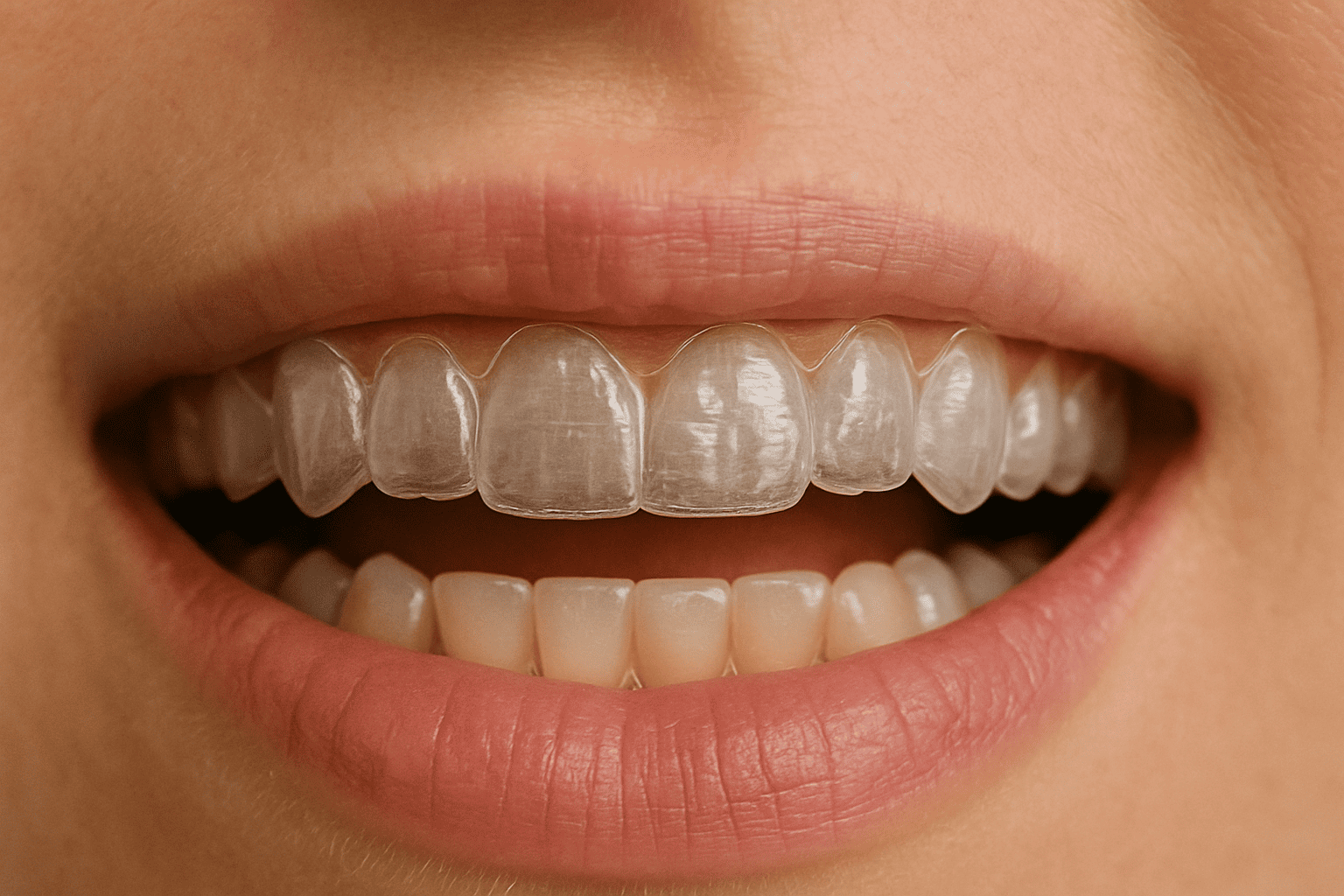What is Teeth Whitening and Is It Safe?
Want a dazzling smile? Teeth whitening safely removes stains for a brighter look. Explore how it works, safe methods, and tips to achieve a confident, radiant smile.
.webp)
A bright, white smile is a universal symbol of confidence and health, and it’s no surprise that teeth whitening has become a global sensation. In the UK, the demand for whitening treatments has skyrocketed. Whether it’s for a special occasion or everyday confidence, millions are turning to whitening solutions to enhance their smiles. But what exactly does teeth whitening involve, and is it safe?
This guide dives into the science, methods, safety considerations, costs, and more, offering clear, expert-backed insights to help you make informed decisions about achieving a brighter smile.
What is Teeth Whitening?
Teeth whitening is a cosmetic dental procedure designed to lighten teeth by removing stains and discoloration, giving your smile a brighter, more vibrant appearance. It typically uses bleaching agents like hydrogen peroxide or carbamide peroxide to target stains caused by coffee, tea, red wine, smoking, or aging. Here’s a look at the main methods available:
- Professional Chairside Whitening: Performed by a dentist, this method uses high-concentration bleaching gels (up to 6% hydrogen peroxide in the UK) for fast, dramatic results, often in a single visit. It’s the gold standard for safety and effectiveness.
- Dentist-Prescribed Home Kits: These involve custom-fitted trays and moderate-strength bleach (usually 6% hydrogen peroxide) for gradual whitening over weeks, offering professional results at home.
- Over-the-Counter (OTC) Products: Whitening strips, toothpastes, and gels with low peroxide levels (capped at 0.1% in the UK) are affordable and convenient but typically ineffectivet.
- Natural Remedies: Trending options like baking soda, activated charcoal, or coconut oil are popular on social media but lack scientific backing and may harm enamel.
Pros and Cons:
- Professional: Quick, safe under dentist supervision, but costs £400–£1,000.
- Home Kits: Safe, convenient, dentist-approved, but slower and gradual, perhaps causing less sensitivity.
- OTC: Budget-friendly (£10–£50), accessible, but weaker results and riskier without oversight.
- Natural: Cheap, trendy, but often abrasive and ineffective, with potential for enamel damage.
The Science Behind Teeth Whitening
Teeth whitening works by using bleaching agents to penetrate the enamel (the outer layer of teeth) and dentin (the layer beneath), where they break down stain-causing molecules called chromogens through a chemical process called oxidation. Hydrogen peroxide is fast-acting, delivering quick results, while carbamide peroxide breaks down more slowly for longer-lasting effects.
In professional treatments, dentists may use LED lights or lasers to accelerate the bleaching process, while home kits rely on prolonged gel contact with teeth. Studies, like those in the British Dental Journal, confirm that regulated whitening agents are effective and safe when used correctly, targeting both surface and deeper stains without harming tooth structure.
Is Teeth Whitening Safe?
When done under professional supervision or with approved products, teeth whitening is generally safe, especially in the UK, where strict regulations limit peroxide levels to ensure consumer safety. However, there are risks to consider, and understanding them is key to a safe whitening experience.
Potential Risks:
- Tooth Sensitivity: Some users experience temporary sensitivity to hot or cold temperatures, which typically fades within a few days. This is more common with chairside treatments.
- Gum Irritation: Bleach can irritate gums if it leaks from trays or is misapplied, causing temporary discomfort.
Minimizing Risks:
- Always consult a GDC-registered dentist to assess your oral health before whitening.
- Avoid illegal treatments, like those offered by non-dental professionals in the UK, which may use various methods..
- Use desensitizing toothpaste post-treatment to ease sensitivity.
- Follow product instructions precisely and limit whitening to every 6–12 months.
Expert Insights: Research from the British Dental Journal and the American Dental Association confirms that regulated whitening methods cause no permanent harm when used as directed. Dentists emphasize that professional oversight minimizes risks and ensures tailored results.
Myths Debunked:
- “Whitening ruins enamel”: False. Approved products, used correctly, are safe for enamel.
- “Natural remedies are safer”: Often false. Baking soda or charcoal can be more abrasive than bleach, which can lead to enamel erosion.
Are Whitening Home Kits Safe?
Whitening home kits can be an excellent option for brightening your smile at home, but are they safe? When used correctly with reputable products, the answer is generally yes; however, there are important considerations to keep in mind.
What Makes Them Safe?
- Most kits use safe bleaching agents, such as hydrogen peroxide or carbamide peroxide, which work effectively when used as directed.
- In the UK, over-the-counter (OTC) kits are limited to 0.1% hydrogen peroxide, making them safer but less potent than dentist-prescribed kits.
- Trusted brands meet strict safety standards.
Who Should Be Cautious?
- Consult a dentist first if you have cavities, gum disease, or sensitive teeth, as whitening may exacerbate these conditions.
- Pregnant or breastfeeding women and kids under 16 should avoid whitening, as there’s not enough safety data.
Tips for Safe Use:
- Pick kits from well-known brands with safety certifications.
- Follow the instructions exactly—don’t use more gel or leave it on longer than recommended.
- Use desensitizing toothpaste if your teeth feel sensitive.
- Avoid sketchy online kits, especially in the UK, where non-dentist prescribed whitening can be illegal.
While home kits are handy and budget-friendly, dentist-prescribed kits or professional treatments might be safer and more effective for some people. With proper care, though, home kits can be a safe way to brighten your smile.
Types of Teeth Discoloration
Not all stains are the same, and understanding their type helps determine the best whitening approach:
- Extrinsic Stains: Surface-level stains from coffee, tea, red wine, or smoking are the easiest to remove with whitening treatments.
- Intrinsic Stains: Deeper stains from medications (e.g., tetracycline), aging, or trauma are harder to treat but can respond to professional whitening.
- Mixed Discoloration: A combination of both may require a tailored approach, often involving a combination of in-office and home treatments.
Cost of Teeth Whitening
In the UK, teeth whitening is a private treatment, as the NHS does not typically cover cosmetic procedures. Costs vary based on the method:
- Professional Treatments: range from £400-1000.
Conclusion
Teeth whitening is a safe and effective way to brighten your smile when done responsibly, especially under the supervision of a GDC-registered dentist. Professional treatments and dentist-prescribed kits outshine OTC products and natural remedies in both safety and results. It’s clear that brighter smiles are in high demand. For the best results, consult a dentist to assess your oral health and avoid illegal or risky treatments. Your smile deserves the best care—choose wisely!
Final Advice: Always verify your provider is GDC-registered via their website and discuss your whitening goals with a dentist. Ready to take the next step? A brighter, more confident smile is within reach!






